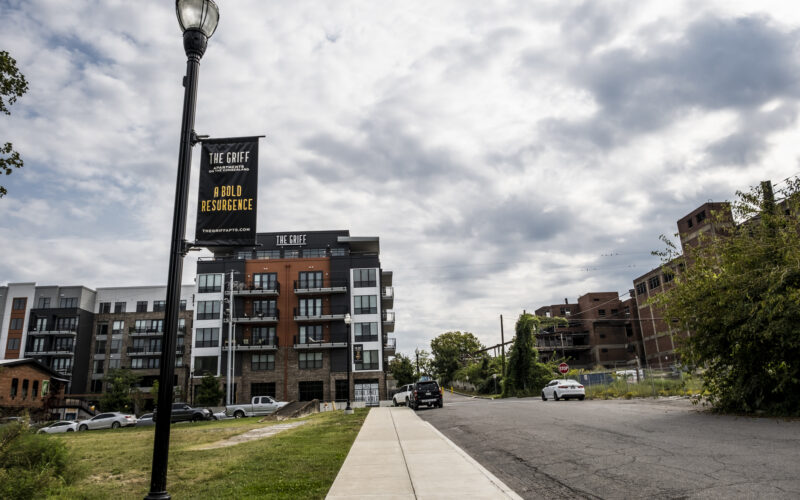Brycia James via iStockphoto
By Matthew Moy
Historic Nashville neighborhoods are changing. Longtime buildings and businesses are being replaced by newer construction projects. Increasingly upscale residential and commercial properties are popping up throughout the city. As indicated by NewsChannel 5, residents believe that the affordability and character of their neighborhoods is changing and leaving them behind.
91.2% of 2022 searches for moves into Tennessee came from states with higher costs of living, with nearly one-quarter hailing from California
Gentrification has been a significant point of concern for Nashville residents in recent years. The idea of gentrification has been used to describe the upscaling of poorer neighborhoods (and cities more broadly) by higher-income individuals or families moving into those neighborhoods. In recent years, Nashville, and Tennessee more broadly, have experienced significant migration from other states in America. This has accompanied rising concerns about gentrification, which would price local Nashvillians out of their communities. According to moving information site MoveBuddha, 91.2% of 2022 searches for moves into Tennessee came from states with higher costs of living, with nearly one-quarter hailing from California, which had the third highest cost of living in the first quarter of 2022 based on data from Missouri Economic Research and Information Center. Higher-income resettlement drives up property values, displacing longtime residents unable to keep up with increasing expenses.
Nashville lies within the most expensive quintile of American and Canadian cities as measured by cost of living (excluding rent), outranking cities such as Denver, Miami and Toronto
Although commonly understood as a real-estate problem raising residential expenses, gentrification can raise non-residential expenses, which could have significant implications for Nashville residents. According to crowdsourced information aggregator Numbeo, Nashville lies within the most expensive quintile of American and Canadian cities as measured by cost of living (excluding rent), outranking cities such as Denver, Miami and Toronto, which were all ranked as more expensive than Nashville as early as 2017. Numbeo’s June 2018 cost of living summary for Nashville indicates that monthly non-rent expenses for a single person totalled $896.19, whereas the same expenses totalled $1,309.90 in November 2023.
The higher costs of regular expenses have caused Vanderbilt students, among others, to look elsewhere for goods and services. Aria Kazemi, a Vanderbilt sophomore, explained that he gets his haircut when he goes home over breaks due to “high prices in Nashville.” Such high prices may contribute to Nashville’s reported price increases, which outpace national inflation by nearly 20%, as calculated by the U.S. Department of Labor. Has Nashville really become 45% more expensive in under six years? If so, can these increases in cost of living really be attributed to gentrification?
If an inexpensive meal costs $20 in Atlanta and Nashville, would local residents be priced out of their fast food by Atlantan migrants?
The short answer is: we don’t know for sure. While the cost of living in Nashville (alongside the rest of the country) has undoubtedly increased over time, it is difficult to discern how much it has increased. Once having discerned how much essential items have appreciated, economists are then left with the task of demonstrating what is driving this appreciation. While many people have left more expensive areas, such as San Francisco and New York, to move to Nashville, it is not clear that they have driven up prices more than someone moving to Nashville from an area with a similar cost of living. Someone moving from San Francisco to Nashville might spend 26.4% less money on groceries, whereas someone moving from Atlanta to Nashville might save only 6.6%. If an inexpensive meal costs $20 in Atlanta and Nashville, would local residents be priced out of their fast food by Atlantan migrants?
People with higher incomes may demand different goods and services than locals with lower incomes. For example, wealthier incoming residents may increase the demand for and market share of expensive products and services. This could then decrease the market share and supply of more affordable products and services, making once affordable services increasingly unaffordable. The economic logic of this theory is sound, but it has yet to be empirically addressed in Nashville.
While opinion pieces addressing gentrification have lined the pages of local newspapers, they have been accompanied by no empirical analysis addressing why costs have increased.
Nashville-focused research has concentrated on identifying the legacies and dynamics of gentrification without quantitatively demonstrating its impact of cost of living. In a 2011 paper, Associate Professor of Sociology Richard Lloyd examined the sociological impacts of gentrification in East Nashville. In a 2019 paper, Vanderbilt alumnus Cameron Hightower worked with former Vanderbilt University professor James Fraser to determine the effects of gentrification in the North Nashville neighborhood. While opinion pieces addressing gentrification have lined the pages of local newspapers, they have been accompanied by no empirical analysis addressing why costs have increased.
With over half of Nashville residents worried about the direction in which the city is headed, it is imperative that economists and other academics systematically study the situation of the city to make sense of how the city is changing. It is not enough for community organizations to demonstrate that costs are rising. If change is deemed important, quantitative empirical analysis must be conducted to fully solidify any necessity for change.




